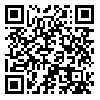Volume 10, Issue 3 (6-2007)
J Arak Uni Med Sci 2007, 10(3): 17-24 |
Back to browse issues page
Download citation:
BibTeX | RIS | EndNote | Medlars | ProCite | Reference Manager | RefWorks
Send citation to:



BibTeX | RIS | EndNote | Medlars | ProCite | Reference Manager | RefWorks
Send citation to:
Bayat A, Fatahi bayat G, Dehdashtian M, Kavyani G, Asadi M, Masoumi A. Early identification of hearing impairment of neonates admitted to neonatal intensive care unit using otoacoustic emissions. J Arak Uni Med Sci 2007; 10 (3) :17-24
URL: http://jams.arakmu.ac.ir/article-1-55-en.html
URL: http://jams.arakmu.ac.ir/article-1-55-en.html
Arash Bayat 
 1, Gholamali Fatahi bayat
1, Gholamali Fatahi bayat 
 , Masoud Dehdashtian
, Masoud Dehdashtian 
 , Gelareh Kavyani
, Gelareh Kavyani 
 , Masoud Asadi
, Masoud Asadi 
 , Abolhosein Masoumi
, Abolhosein Masoumi 


 1, Gholamali Fatahi bayat
1, Gholamali Fatahi bayat 
 , Masoud Dehdashtian
, Masoud Dehdashtian 
 , Gelareh Kavyani
, Gelareh Kavyani 
 , Masoud Asadi
, Masoud Asadi 
 , Abolhosein Masoumi
, Abolhosein Masoumi 

1- , arashbayat2004@yahoo.com
Abstract: (19111 Views)
Introduction: It is well recognized that hearing is critical to speech and language development, communication, and learning. Otoacoustic emission (OAE) is an efficient and sensitive method to identify subjects at risk for auditory impairment. Infants who require admission to neonatal intensive care unit are reported to be at 10-20 times greater risk for hearing impairment. The porpuse of this study was to investigate the incidence of hearing impairment in neonates screened by OAE.
Materials and Methods: In a cross-sectional study, 148 newborns having risk factors for hearing impairment reffering to Taleghani hospital of Arak and Aboozar hospital of Ahwaz were evaluated. All clients had normal otoscopic findings. Transient evoked (TEOAE) and distortion-product otoacoustic emissions (DPOAEs) were measured in both ears. If the results of otoacoustic emissions were not normal, these tests were repeated one month later. Patients who did not pass the second stage were reffered for comprehensive auditory evaluations. Data analysis was performed using Kolmogrov-Smirnov and t-tests.
Results: 41 and 28 cases could not pass the examining test at the first TEOAE and DPOAE examination, respectively. Also, 23 and 16 cases did not pass the examining test at the second TEOAE and DPOAE evaluations, respectively. These participants underwent auditory brainstem response evaluation and 11 of them had abnormal responses. In 5 cases of confirmed ones, hearing impairment was due to aminoglycoside side effects.
Conclusion: OAE hearing screening of at-risk newborns is a clinically beneficial approach to early detection of hearing impairment. Regarding the high prevalence of hearing loss in our subjects (7.43%), prevention of its complications is highly recommended in this population.
Subject:
General
Received: 2008/09/28
Received: 2008/09/28
Send email to the article author
| Rights and permissions | |
 |
This work is licensed under a Creative Commons Attribution-NonCommercial 4.0 International License. |



